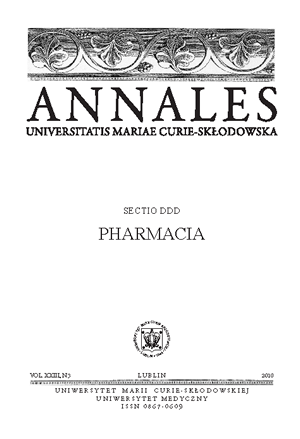Rak gruczołu piersiowego – problem epidemiologiczny i społeczny w Polsce
Słowa kluczowe:
rak piersi, epidemiologia, czynniki ryzykaAbstrakt
Rak gruczołu piersiowego jest najczęściej występującym u kobiet nowotworem złośliwym. Wczesna diagnostyka i efektywne działania profilaktyczne umożliwiają obniżenie wskaźników umieralności nawet o 30%. Problem raka gruczołu piersiowego w Polsce dotyczy obecnie 55000 kobiet. Rocznie stwierdza się w kraju około 13500 nowych zachorowań (42/100000 mieszkańców). Współczynnik umieralności wynosi obecnie 15/100000. W ostatnich latach obserwuje się stabilizację współczynnika umieralności pomimo wzrostu liczby zachorowań, co jak się przypuszcza jest wynikiem znacznej poprawy wczesnej diagnostyki i leczenia tego typu nowotworu. Wciąż jednak zbyt mała liczba kobiet zgłasza się na populacyjne badania profilaktyczne (31%), a wyliczony za okres przed rokiem 2006 wskaźnik 5-letniego przeżycia wynosi w Polsce zaledwie 72%. W pracy przedstawiono również poznane dotychczas główne czynniki ryzyka zachorowania na raka piersi.
Bibliografia
1. Sasco A. Epidemiology of breast cancer: an environmental disease? APMIS. 2001, 109: 321-332.
2. Verdecchia A. et al. Recent cancer survival in Europe: a 2000-02 period analysis of EUROCARE-4f date Working Group. Lancet Oncol. 2007, 8: 784-796.
3. Brinton L.A. Ways that women may possibility reduce their risk of breast cancer. J. Natl. Cancer Inst. 1994, 86: 1371.
4. Rzymowska J. Morfologiczne, molekularne i biochemiczne aspekty neoadiuwantowej chemioterapii Ansfielda stosowanej w leczeniu raka piersi. PWZN, Lublin, 2002, 5: 183.
5. Chu K.C. et al. Recent trends in US breast cancer incidence, survival and mortality rates. J. Natl. Cancer Inst. 1996, 88: 1571-1579.
6. Jansen R.L.H. et al. Relevance of expression of Bcl-2 in combination with p53 as a prognostic factor in breast cancer. Anticancer Res. 1998, 18: 4455-4462.
7. Krzakowski M. Rak piersi. Zalecenia diagnostyczno-terapeutyczne Polskiej Unii Onkologii. Nowotwory. Journal of Oncology. 2003, 53: 300-324,.
8. Wojciechowska U. et al. Nowotwory złośliwe w Polsce w 2006 roku. Centrum Onkologii – Instytut, Warszawa, 2008.
9. Anttila A., Ronco G. Working Group on the Registration and Monitoring of Cervical Cancer Screening Programs in the European Union; within the European Network for Information on Cancer (EUNICE). Eur. J. Cancer. 2009, 2685: 708.
10. Krzakowski M. Zalecenia postępowania diagnostyczno-terapeutycznego w nowotworach złośliwych u dorosłych. Polska Unia Onkologii, Warszawa, 2003: 108-140,.
11. Pawlicki M. Rak piersi – nowe nadzieje i możliwości leczenia. α-medica press, Bielsko-Biała, 2002: 27.
12. Dimitrov S.D. et al.: Expression of BRCA1, NBR1 and NBR2 genes in human breast cancer cells. Folia Biol. 2001, 47: 120-127.
13. Beenken S.W., Bland K.I. Breast cancer: cellular, biochemical, and molecular biomarkers. In: Cameron J.: Current surgical therapy. Mosby, St Louis, 2001: 697-701.
14. Pieńkowski T. Rak piersi. In: Krzakowski M. Onkologia kliniczna. Wyd. Medyczne Borgis. 2001: 87-139.
15. Pawlęga J. Epidemiologia. In: Jassem J.: Rak sutka. Springer PWN, Warszawa, 1998: 31-59.
16. Silverstein M.J. Ductal carcinoma in situ of the breast. Br. J. Surg. 1997, 84: 145-146.
17. Leonard G. D., Swain S.M. Ductal carcinoma In situ, compexities and challenges. J. Natl. Cancer Inst. 2004, 96: 906-920.
18. Eusebi V. et al. Long-term follow up of in situ carcinoma of the breast. Semin. Diagn. Pathol. 1994, 11: 223-235.
19. Ross R.K. et al. Effect of hormone replacement therapy on breast cancer risk: oestrogen versus oestrogen plus progestin. J. Natl. Cancer Inst. 2000, 92: 328-332.
20. Spicer D.V., Pike M.C. Sex steroids and breast cancer prevention. Natl. Cancer Inst. Monogr. 1994, 16: 139.
21. Pujol P. et al. Rising levels of oestrogen receptors in breast cancer decades. Cancer, 1994, 74: 1601.
22. Schairer C. et al. Menopausal oestrogen and oestrogen-progestin replacement therapy and breast cancer risk. JAMA. 2000, 283: 485-491.
23. Brewster A., Helzlsouer K. Epidemiology, prophylaxis and early diagnosis in breast cancer. C. O. Oncol. 2001, 13: 420-425.
24. Marchbanks P.A. et al. Oral contraceptives and the risk of breast cancer. N. Eng. J. Med. 2002, 346: 2025-2032.
25. Beral V. et al. Breast cancer and breastfeeding: collaborative reanalysis of individual data from 47 epidemiological studies in 30 countries, including 50302 women with breast cancer and 96973 women without the disease. Lancet. 360, 2002, 187-195.
26. Holmes M.D., Wilett W.C.: Does diet affect breast cancer risk? Breast Cancer Res. 2004, 6: 170-178.
27. McPherson K. et al. Breast cancer epidemiology, risk factors and genetics. BMJ. 1994, 309: 1003.
Pobrania
Opublikowane
Numer
Dział
Licencja
Prawa autorskie (c) 2010 Autorzy

Praca jest udostępniana na licencji Creative Commons Attribution-NonCommercial-NoDerivatives 3.0 Unported License.


